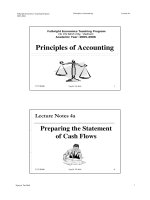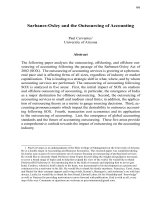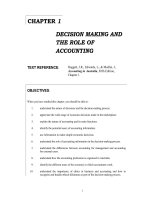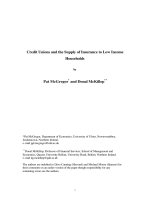international economics _National Income Accounting and the Balance of Payments exercise
Bạn đang xem bản rút gọn của tài liệu. Xem và tải ngay bản đầy đủ của tài liệu tại đây (672.31 KB, 47 trang )
International Economics, 8e (Krugman)
Chapter 12
National Income Accounting and the Balance of Payments
12.1
The National Income Accounts
1)
A country's gross national product (GNP) is
A)
the value of all final goods and services produced by its factors of production and sold on the market in a given time
period.
B)
the value of all intermediate goods and services produced by its factors of production and sold on the market in a given
time period.
C)
the value of all final goods produced by its factors of production and sold on the market in a given time period.
D)
the value of all final goods and services produced by its factors of production and sold on the market.
E)
the value of all final goods and services produced by its factors of production, excluding land, and sold on the market in a
given time period.
Answer:
A
Question Status:
New
2)
For most macroeconomists,
A)
national income accounts and national output accounts are equal to each other.
1
B)
national income accounts exceed national output accounts.
C)
national output accounts exceed national income accounts.
D)
it is impossible to tell whether national income accounts equal to national output accounts.
E)
None of the above.
Answer:
A
Question Status:
New
3)
For most macroeconomists,
A)
gross national income and gross national product are the same.
B)
gross national income exceeds gross national product.
C)
gross national product exceeds gross national product.
D)
it is hard to tell whether gross national income equal gross national product.
E)
None of the above.
Answer:
A
Question Status:
New
2
4)
The highest component of GNP is,
A)
the current account.
B)
investment.
C)
government purchases.
D)
consumption.
E)
None of the above.
Answer:
D
Question Status:
New
5)
An example of how GNP accounts for services provided by foreign-owned capital (and GDP does not) is
A)
earnings of Spanish factory with British owners counts only in Spain's GDP.
B)
earnings of Spanish factory with British owners counts only in Britain's GNP.
C)
earnings of Spanish factory counts in Spain's GNP but are part of Britain's GDP.
D)
earnings of Spanish factory counts in Spain's GDP but are part of Britain's GNP.
E)
None of the above.
Answer:
3
D
Question Status:
New
6)
The sale of
A)
a used textbook does enter GNP.
B)
a used textbook does not enter GNP, but the sale of a used house does.
C)
both a used textbook and a used house do not enter GNP.
D)
a used house does not enter GNP, but the sale of a used book does.
E)
None of the above.
Answer:
C
Question Status:
New
7)
Which one of the following statements is the most accurate?
A)
The sale of a used textbook does generate income for factors of production.
B)
The sale of a used textbook does not generate income for any factor of production.
C)
The sale of a used textbook sometimes does and sometimes does not generate income for factors of production.
D)
4
It is hard to tell whether a sale of a used textbook does or does not generate income for factors of production.
E)
None of the above.
Answer:
B
Question Status:
New
8)
Which one of the following statements is the most accurate?
A)
GNP plus depreciation is called net national product (NNP).
B)
GNP less depreciation is called net national product (NNP).
C)
GNP less depreciation is called net factor product (NFP).
D)
Answers A and C are both correct.
E)
None of the above.
Answer:
B
Question Status:
New
9)
National income equals GNP
A)
less depreciation, less net unilateral transfers, less indirect business taxes.
B)
less depreciation, plus net unilateral transfers, plus indirect business taxes.
5
C)
less depreciation, less net unilateral transfers, plus indirect business taxes.
D)
plus depreciation, plus net unilateral transfers, less indirect business taxes.
E)
less depreciation, plus net unilateral transfers, less indirect business taxes.
Answer:
E
Question Status:
New
10)
The United States began to report its gross domestic product (GDP) only since
A)
1900.
B)
1921.
C)
1931.
D)
1941.
E)
1991.
Answer:
E
Question Status:
New
6
11)
GDP is supposed to measure
A)
the volume of production within a country's borders.
B)
the volume of services generated within a country's borders.
C)
the volume of production of a country's output.
D)
GNP plus depreciation.
E)
None of the above.
Answer:
A
Question Status:
New
12)
GNP equals GDP
A)
minus net receipts of factor income from the rest of the world.
B)
plus receipts of factor income from the rest of the world.
C)
minus receipts of factor income from the rest of the world.
D)
plus net receipts of factor income from the rest of the world.
E)
None of the above.
Answer:
7
D
Question Status:
New
13)
Movements in GDP
A)
and GNP usually do not differ greatly.
B)
and GNP usually do not differ greatly, as a practical matter.
C)
and GNP usually do differ greatly.
D)
are usually smaller than those of GNP movements, in practice.
E)
None of the above.
Answer:
B
Question Status:
New
14)
In 2006, the United States had
A)
a surplus in the current account.
B)
a balance in the current account.
C)
a deficit in the current account.
D)
8
From 2006 data, it is too difficult to determine whether a surplus or a deficit existed in the current account.
E)
None of the above.
Answer:
C
Question Status:
New
15)
Net unilateral transfers
A)
are part of a national income.
B)
are part of a country's product.
C)
must be added to NNP in calculations of national income.
D)
are part of a country's GNP.
E)
Only A and C.
Answer:
E
Question Status:
New
9
16)
GDP is different than GNP in that
A)
it accounts for net unilateral transfers.
B)
it does not account for indirect business taxes.
C)
it does not account for a country's production using services with foreign-owned capital.
D)
it accounts for depreciation.
E)
None of the above.
Answer:
C
Question Status:
New
17)
What are the main aspects of economic life that macroeconomics analysis is most concerned with?
Answer:
There are four main aspects: unemployment, saving, trade imbalances, and money and the price level.
Question Status:
New
18)
What can you learn from the figure below (Figure 12-1 from the text) which depicts the U.S. GNP and its components for
the year 2006?
10
Answer:
The highest component of GNP is consumption and the U.S. has a negative current balance.
Question Status:
New
12.2
National Income Accounting for an Open Economy
1)
Movements in GDP
A)
differ greatly from movements in GNP.
B)
do not differ greatly from movements in GNP.
C)
are not allowed to differ at all from movements in GNP by definition.
D)
need to be inflation adjusted in order to match movements in GNP.
E)
None of the above.
11
Answer:
B
Question Status:
New
12
2)
Purchases of inventories by
A)
firms are not counted in investment spending.
B)
firms are also counted in investment spending.
C)
households are also counted in investment spending.
D)
households and Firms are also counted in investment spending.
E)
None of the above.
Answer:
B
Question Status:
New
3)
In open economies,
A)
saving and investment are necessarily equal.
B)
as in a closed economy, saving and investment are not necessarily equal.
C)
saving and investment are not necessarily equal as they are in a closed economy.
D)
saving and investment are necessarily equal contrary to the case of a closed economy.
E)
None of the above.
Answer:
13
C
Question Status:
New
4)
Investment is usually
A)
more variable than consumption.
B)
less variable than consumption.
C)
as variable as consumption.
D)
It is hard to tell from the data whether investment is more or less variable than consumption.
E)
None of the above.
Answer:
A
Question Status:
New
5)
Government purchases are defined as
A)
only goods purchased by federal, state, or local governments.
B)
all goods and services purchased by the federal government.
C)
all goods and services purchased by the federal or state government.
D)
14
all goods and services purchased by the federal, state, or local government.
E)
None of the above.
Answer:
D
Question Status:
New
6)
Government transfer payments like social security and unemployment benefits are
A)
included in government purchases.
B)
not included in government purchases.
C)
not included in government purchases, but they are included in the consumption component of GNP.
D)
not included in government purchases, but they are part of the investment component of GNP.
E)
None of the above.
Answer:
B
Question Status:
New
7)
In 1929, government purchases accounted for
A)
only 18.5 percent of U.S. GNP.
B)
only 8.5 percent of U.S. GNP.
15
C)
28.5 percent of U.S. GNP.
D)
38.5 percent of U.S. GNP.
E)
48.5 percent of U.S. GNP.
Answer:
B
Question Status:
New
8)
Which one of the following expressions is the most accurate?
A)
CA = EX - IM
B)
CA = IM - EX
C)
CA = EX = IM
D)
CA = EX + IM
E)
None of the above.
Answer:
A
Question Status:
New
9)
A country's current account
16
A)
balance equals the change in its net foreign wealth.
B)
balance equals the change in its foreign wealth.
C)
surplus equals the change in its foreign wealth.
D)
deficit equals the change in its foreign wealth.
E)
None of the above.
Answer:
A
Question Status:
New
10)
The CA is equal to
A)
Y - (C - I + G).
B)
Y + (C + I + G).
C)
Y - (C + I + G).
D)
Y - (C + I - G).
E)
None of the above.
Answer:
A
Question Status:
17
New
11)
Which of the following is true?
A)
A country with a current account surplus is earning more from its exports than it spends on imports.
B)
A country could finance a current account deficit by using previously accumulated foreign wealth to pay for its imports.
C)
A country with a current account deficit must be increasing its net foreign debts by the amount of the deficit.
D)
We can describe the current account surplus as the difference between income and absorption.
E)
All of the above are true.
Answer:
E
Question Status:
New
12)
Over the 1980s,
A)
there is no question that a large increase in U.S. foreign assets did occur.
B)
there is a question whether a large decrease in U.S. foreign assets did occur.
C)
there is no question that a large decrease in U.S. foreign assets did occur.
D)
there is no question that there was almost no change in U.S. foreign assets.
E)
None of the above.
18
Answer:
C
Question Status:
New
19
13)
In a closed economy, national saving
A)
sometimes equals investment.
B)
always equals investment.
C)
is always less than investment.
D)
is always more than investment.
E)
None of the above.
Answer:
B
Question Status:
New
14)
For open economies,
A)
S = I.
B)
S = I + CA.
C)
S = I - CA.
D)
S > I + CA.
E)
S < I + CA.
Answer:
20
B
Question Status:
New
15)
An open economy
A)
can save only by building up its capital stock.
B)
can save only by acquiring foreign wealth.
C)
cannot save either by building up its capital stock or by acquiring foreign wealth.
D)
can save either by building up its capital stock or by acquiring foreign wealth.
E)
None of the above.
Answer:
D
Question Status:
New
16)
A closed economy
A)
can save either by building up its capital stock or by acquiring foreign wealth.
B)
can save only by building up its capital stock.
C)
can save only by acquiring foreign wealth.
D)
21
cannot save either by building up its capital stock or by acquiring foreign wealth.
E)
None of the above.
Answer:
B
Question Status:
New
17)
Disposable income is National income
A)
less taxes collected from households and firms by the government.
B)
plus net taxes collected from households and firms by the government.
C)
less net taxes collected from households and firms by the government.
D)
less net taxes collected from households by the government.
E)
less net taxes collected from households and firms by the government.
Answer:
E
Question Status:
New
18)
Government savings, S
g
, is equal to
A)
T - G.
B)
22
T + G.
C)
T = G.
D)
T + G - I.
E)
None of the above.
Answer:
A
Question Status:
New
19)
Which of the following is false about private savings and government savings?
A)
S
P
= Y - T - C
B)
Unlike private saving decisions, government saving decisions are often made with an eye toward their effect on output
and employment.
C)
Total savings (S) = S
P
+ S
g
.
D)
The national income identity can help us to analyze the channels through which government saving decisions influence
macroeconomic conditions.
E)
None of the above; all statements are true.
Answer:
E
Question Status:
New
23
20)
In a closed economy, private saving, S
p
, is equal to
A)
I - (G - T).
B)
I + (G - T).
C)
I + (G + T).
D)
I - (G + T).
E)
I + (G - T) + C.
Answer:
B
Question Status:
New
21)
In an open economy, private saving, S
p
, is equal to
A)
I - CA + (G - T).
B)
I + CA - (G - T).
C)
I + CA + (G - T).
D)
I - CA - (G - T).
E)
I + CA + (G + T).
24
Answer:
C
Question Status:
New
22)
Ricardian equivalence argues that when the government cuts taxes and raises its deficit,
A)
consumers anticipate that they will face lower taxes later to pay for the resulting government debt.
B)
consumers anticipate that they will higher services from the government.
C)
consumers anticipate that they will face higher taxes later to pay for the resulting government debt.
D)
consumers anticipate it will affect their future taxes, in general in the direction of lowering future taxes.
E)
None of the above.
Answer:
C
Question Status:
New
25









